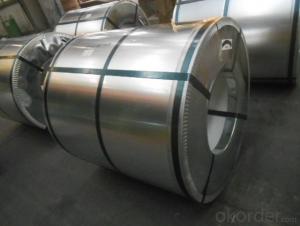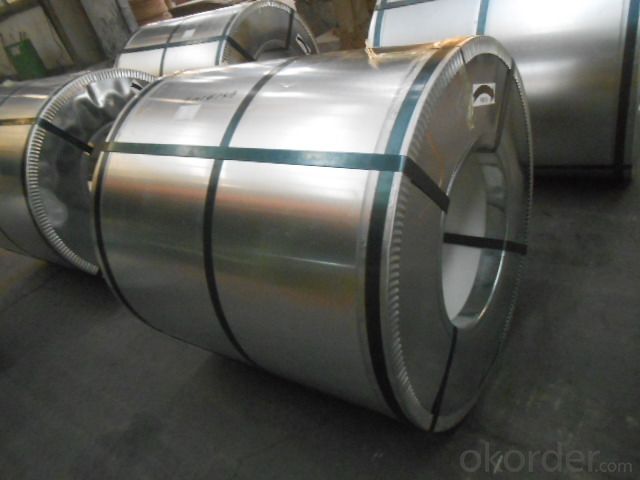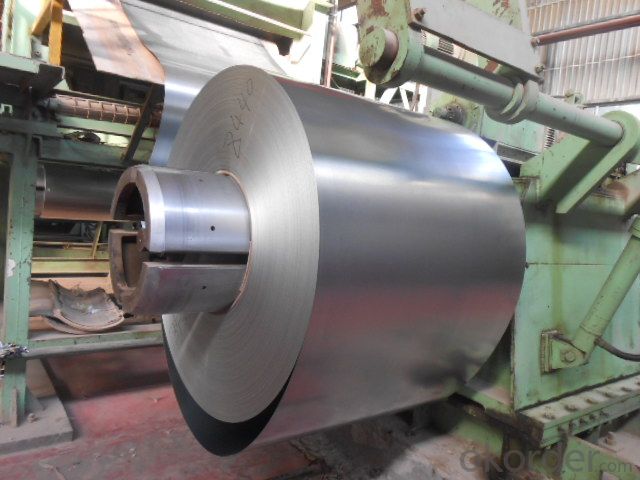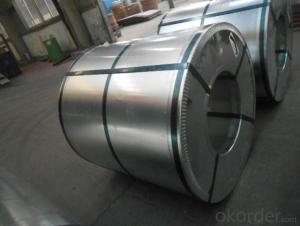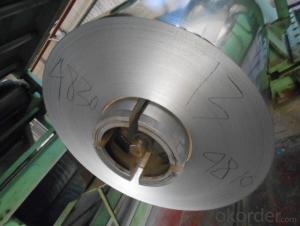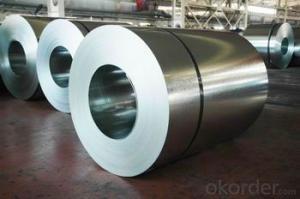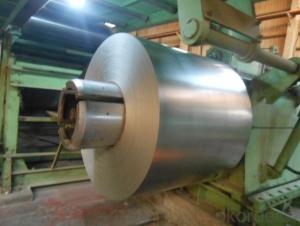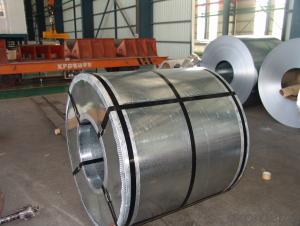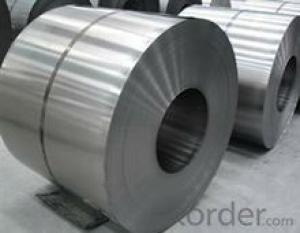Hot-dipped Galvanized Steel Coil In coil
- Loading Port:
- Tianjin
- Payment Terms:
- TT OR LC
- Min Order Qty:
- 25 m.t.
- Supply Capability:
- 2000 m.t./month
OKorder Service Pledge
OKorder Financial Service
You Might Also Like
Galvanized Steel Coil gets coated in layers of zinc because rust won't attack this protective metal. The most external layer is all zinc, but successive layers are a mixture of zinc and iron, with an interior of pure steel. These multiple layers are responsible for the amazing property of the metal to withstand corrosion-inducing circumstances. Zinc also protects the steel by acting as a "sacrificial layer." If rust does take hold on the surface of Galvanized Steel Coil, the zinc will get corroded first. This allows the zinc that is spread over the breach or scratch to prevent rust from reaching the steel. For countless outdoor, marine, or industrial applications, Galvanized Steel Coil is an essential fabrication component.
Superiority
1. Good Resistance to Corrosion
2. Qualified Processing Machinability
3. High Thermal Resistance
4. Excellent Reflectivity
5. Inexpensive and effective enough
6. Can be recycled and reused multiple times
STEEL GRADE & STANDARD:JIS G3302 SGCC
ZINC COATING MASS:Z09
SPANGLE:REGULAR SPANGLE
SURFACE TREATMENT:CHROMATED,UNOILED,NONSKINPASSED
SIZE:0.58*1200MM
COIL ID:508MM
COIL WEIGHT:4-7MT
- Q: Just wondering how good are forge steel screw drivers, tool boxes(organisers) and pliers are, as screw fix are having a january sale, and looking to add to my tool collection. Thanks in advance
- Go craftsman not bad prices and lifetime warranty.
- Q: Are steel coils resistant to rust and corrosion?
- Steel coils exhibit resistance to rust and corrosion. Typically, these coils are crafted from either carbon steel or stainless steel, both of which possess exceptional properties for combating corrosion. Carbon steel coils are frequently coated with a protective layer, such as zinc or a polymer coating, to augment their resistance to rust and corrosion. Conversely, stainless steel coils possess inherent corrosion-resistant qualities due to the presence of chromium. This element creates a protective oxide layer on the steel's surface, effectively preventing rust and corrosion. Nonetheless, it is crucial to acknowledge that the extent of resistance may also hinge on the specific grade and quality of the steel employed in the coils, as well as the environmental conditions to which they are exposed.
- Q: Does anyone know the lyrics to steel driving man by Dailey and Vincent. I would really appreciate it
- watch man of steel full movie online free adf.ly/dfxYD
- Q: What minerals are mixed to make steel?
- Carbon and Iron.....usually.
- Q: What are the common international standards for steel coils?
- The common international standards for steel coils include ASTM A653/A653M, JIS G3302, EN 10346, and GB/T 2518. These standards specify the requirements for the chemical composition, mechanical properties, and dimensions of steel coils used in various industries.
- Q: How do steel coils contribute to the manufacturing of appliances?
- Steel coils play a crucial role in the manufacturing of appliances. These coils are typically made from high-quality steel and are used in various stages of appliance production. Firstly, steel coils are used in the fabrication of appliance components. Manufacturers use these coils to create the outer and inner casings of appliances such as refrigerators, washing machines, and dishwashers. The sturdy nature of steel ensures durability and provides a protective barrier for the inner workings of the appliance. Moreover, steel coils are utilized in the production of appliance parts. These coils are often cut, shaped, and formed into smaller components like brackets, frames, and panels. These parts are essential for the proper functioning of appliances and contribute to their overall performance and longevity. Steel coils also contribute to the manufacturing of appliance doors. The coils are molded and shaped to create the doors, which are crucial for the accessibility and safety of the appliance. Steel doors offer strength, security, and insulation, making them an ideal choice for appliances. Furthermore, steel coils are used in the manufacturing of heating elements and burners in appliances like stoves and ovens. These coils are designed to withstand high temperatures and provide efficient heat transfer, ensuring the appliances can cook or bake food effectively. Overall, steel coils are an integral part of the appliance manufacturing process. They are used to create the outer casings, essential components, doors, and heating elements of appliances. The use of steel in these applications enhances durability, safety, and overall performance, making appliances more reliable and long-lasting.
- Q: What are the different types of welding methods used for steel coils?
- There are several different types of welding methods commonly used for steel coils, including spot welding, seam welding, and flash butt welding. Spot welding involves applying heat and pressure to two overlapping pieces of metal to create a strong bond. Seam welding is similar to spot welding but is used for continuous welds along the length of the coil. Flash butt welding involves using an electric current to create a heat source between two ends of the coil, which are then pressed together to form a solid weld. These methods allow for efficient and effective joining of steel coils in various industrial applications.
- Q: How are steel coils used in the manufacturing of metal furniture?
- Steel coils are an essential component in the manufacturing of metal furniture. These coils are typically made from high-quality steel, which provides strength, durability, and stability to the furniture. The first step in using steel coils in the manufacturing process is to cut them into the desired length and width. This is done using specialized machinery and tools, ensuring precise and accurate dimensions for the furniture components. Once the coils are cut, they are then shaped and formed into various furniture parts such as chair frames, table bases, or cabinet structures. The coils can be bent, welded, or manipulated to create the desired shapes and designs. After the shaping process, the steel coils are further processed to enhance their aesthetic appeal and protection against corrosion. This involves sanding, polishing, and applying protective coatings or finishes to give the furniture a smooth and attractive surface. In addition to providing structural support and visual appeal, steel coils also contribute to the overall functionality of metal furniture. They offer excellent load-bearing capacity, ensuring that the furniture can withstand weight and pressure without bending or breaking. Moreover, steel coils make metal furniture more resistant to wear and tear, making it suitable for both indoor and outdoor use. They can withstand harsh weather conditions, making them ideal for patio furniture or outdoor seating arrangements. Overall, steel coils are indispensable in the manufacturing of metal furniture, playing a crucial role in providing strength, durability, and aesthetic appeal. Their versatility and reliability make them a preferred choice for furniture manufacturers worldwide.
- Q: What are the dimensions of steel coils used in the aerospace industry?
- The dimensions of steel coils used in the aerospace industry can vary depending on the specific application and requirements. However, generally speaking, aerospace-grade steel coils tend to have standardized dimensions to ensure compatibility and ease of use. Typically, the thickness of steel coils used in the aerospace industry ranges from 0.008 inches (0.2 mm) to 0.125 inches (3.2 mm). The width can vary from around 0.5 inches (12.7 mm) to 72 inches (1829 mm), although narrower widths are more common. The length of the coil can range from several hundred feet to thousands of feet, depending on the needs of the specific aerospace manufacturer. It's important to note that these dimensions are not fixed and can be customized based on the requirements of the aircraft or aerospace component being manufactured. The dimensions of steel coils may also differ depending on the specific steel alloy being used and the manufacturing processes involved. Ultimately, the dimensions of steel coils in the aerospace industry are determined by factors such as strength, weight, durability, and the specific needs of the aerospace manufacturer or project.
- Q: How are steel coils used in the manufacturing of storage racks?
- Steel coils are used in the manufacturing of storage racks by being cut into smaller, more manageable pieces that are then shaped and welded into the desired rack structure. The strength and durability of the steel coils make them an ideal material for supporting heavy loads and ensuring the stability of the storage racks.
Send your message to us
Hot-dipped Galvanized Steel Coil In coil
- Loading Port:
- Tianjin
- Payment Terms:
- TT OR LC
- Min Order Qty:
- 25 m.t.
- Supply Capability:
- 2000 m.t./month
OKorder Service Pledge
OKorder Financial Service
Similar products
Hot products
Hot Searches
Related keywords
